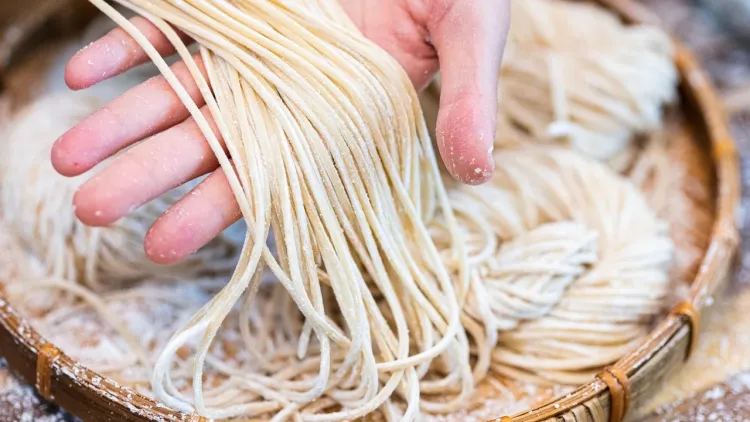Exploring the World of Noodles: A Flavorful Adventure...!!!
Noodles are a versatile and beloved food that transcends cultural boundaries. Whether it's a comforting bowl of ramen on a rainy day, a plate of pad thai at a bustling street market, or a rich fettuccine Alfredo at an Italian trattoria, noodles have a way of bringing people together.

Noodles are a staple food in many cultures, especially in Asia. The process of making noodles can vary depending on the type, but the basic principles are often similar.
-
Ingredients:
-
Flour: The base of noodles, often wheat flour, but other types like rice, buckwheat, or other flours can also be used.
-
Water: Essential for forming the dough.
-
Salt: Adds flavor and helps in the gluten development.
-
Eggs: (Optional) Used in some recipes for added richness and texture.
-
-
Mixing and Kneading:
-
Combine the flour and salt in a bowl.
-
Gradually add water (and eggs, if using) while mixing until a dough forms.
-
Knead the dough until it becomes smooth and elastic, which usually takes around 10-15 minutes.
-
-
Resting the Dough:
-
Cover the dough with a damp cloth and let it rest for at least 30 minutes to relax the gluten and make it easier to roll out.
-
-
Rolling and Cutting:
-
Roll out the dough on a lightly floured surface to the desired thickness.
-
Cut the dough into thin strips for noodles using a knife or a pasta machine.
-
-
Cooking:
-
Cook the noodles in boiling water for a few minutes until they are al dente.
-
Drain and rinse with cold water to stop the cooking process, especially for some Asian noodles.
-
Types of Noodles
Noodles come in a wonderful variety of shapes, sizes, and ingredients, reflecting the culinary diversity around the world. Here are some popular types:
-
Wheat Noodles:
-
Ramen: Japanese noodles made from wheat flour, water, salt, and kansui (alkaline water). Often served in a rich broth.
-
Udon: Thick, chewy Japanese wheat noodles, typically served in hot broth.
-
Soba: Japanese noodles made from buckwheat flour, known for their nutty flavor and often served cold with dipping sauce or hot in broth.
-
-
Rice Noodles:
-
Pho: Vietnamese rice noodles often served in a savory broth with herbs and meats.
-
Pad Thai: Thai stir-fried noodles made from rice flour, usually served with a tamarind-based sauce, shrimp, tofu, and peanuts.
-
-
Egg Noodles:
-
Lo Mein: Chinese wheat and egg noodles, commonly stir-fried with vegetables and protein.
-
Chow Mein: Similar to lo mein but typically crispier, made by frying the noodles before mixing with other ingredients.
-
-
Glass Noodles:
-
Cellophane Noodles: Also known as mung bean or bean thread noodles, they become transparent when cooked and are used in various Asian dishes.
-
-
Specialty Noodles:
-
Soba Noodles: Japanese buckwheat noodles, ideal for cold dishes in summer.
-
Shirataki Noodles: Made from the konjac yam, they are low in calories and carbohydrates, popular in keto and low-carb diets.
-
-
Italian Pasta:
-
Spaghetti: Long, thin noodles usually made from durum wheat semolina. Commonly served with tomato-based sauces.
-
Fettuccine: Flat, thick noodles often paired with creamy sauces like Alfredo.
-
-
Other Varieties:
-
Laksa: Spicy Malaysian and Singaporean noodle soup made with rice vermicelli.
-
Mie Goreng: Indonesian stir-fried noodles made from wheat flour, often served with a sweet and savory sauce.
-
Noodles are a versatile and beloved food that transcends cultural boundaries. Whether it's a comforting bowl of ramen on a rainy day, a plate of pad thai at a bustling street market, or a rich fettuccine Alfredo at an Italian trattoria, noodles have a way of bringing people together. Their simplicity in ingredients and the complexity in flavors and textures make them a culinary delight worth exploring. Enjoy experimenting with different types of noodles and cooking methods to discover your favorites
What's Your Reaction?


















